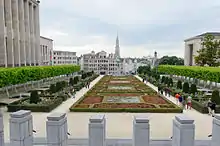
Call Brussels, also known by its hashtag #CallBrussels, was an initiative by which people from around the world could dial public telephones in the Belgian capital Brussels, which were then answered by locals. It was initiated in January 2016 by Belgian tourist organisations to counter negative coverage of the city in relation to Islamist militants based within it. The official video of the initiative was pulled from YouTube after March 2016's Brussels attacks.
Description
After the November 2015 Paris attacks, several people from the Brussels neighbourhood of Sint-Jans-Molenbeek were arrested in connection to it, following a four-day lockdown across the capital. The lockdown cost the city €350 million, while tourist numbers in December 2015 fell 20% on the previous December.[1] The Call Brussels website said "At the moment, many tourists still hesitate about coming to visit our magnificent capital. The Level 4 alert and lockdown are still fresh in their memory. Which is a pity because for those who live in Brussels, everything is normal in the city..."[2]
Via an Internet connection,[1] members of the public can ring one of three public phones, at Mont des Arts, Place Flagey and Molenbeek.[2] Calls were answered from 7 to 11 January 2016.[3]
After the calls ended, a video was compiled of them by Visit Brussels, including one in which a Belgian man says "Well actually it's the media that's made a whole fuss about it, but nothing is happening." The video was pulled after the 22 March Brussels attacks.[4]
References
- 1 2 Rankin, Jennifer (9 January 2016). "Safe to talk? Brussels invites foreigners to call city and chat to locals". The Guardian. Retrieved 29 March 2016.
- 1 2 Goenka, Himanshu (9 January 2016). "CallBrussels, A New Tourism Initiative To De-Link Brussels With Terrorism". International Business Times. Retrieved 29 March 2016.
- ↑ "Call Brussels". Visit Brussels. Archived from the original on 23 March 2016. Retrieved 29 March 2016.
- ↑ "CallBrussels tourism ad pulled after bombings". 9 News. 24 March 2016. Retrieved 29 March 2016.